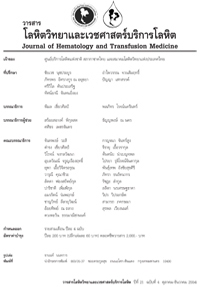การทดสอบแอนติเจนสังเคราะห์ MUT/Mur Kodecytes กับ Anti-Mia ในผู้บริจาคโลหิต
Keywords:
Kodecytes, MUT, Mur, Variant MNS, Anti-MiaAbstract
บทคัดย่อ
ปัจจุบันมีเทคโนโลยีใหม่ในระดับชีวโมเลกุลสำหรับสร้างแอนติเจนสังเคราะห์บนผิวเม็ดเลือดแดงคือ KODETM Biosurface Engineering Technology หรือ KODETM Peptide Antigen (PA) Technology ใช้สำหรับผลิตเซลล์มาตรฐาน (standard red cell reagents) วัตถุประสงค์ : เพื่อทดสอบผลิตภัณฑ์ 3% AbtectcellTM III antibody screening cells และ 3% PhenocellTM antibody identification cells ของบริษัท CSL Limited ซึ่งเป็นผลิตภัณฑ์เซลล์เม็ดเลือดแดงที่มีแอนติเจนสังเคราะห์ (MUT/Mur kodecytes) วัสดุและวิธีการ : ตัวอย่างน้ำเหลืองจากผู้บริจาคโลหิตที่ตรวจพบ anti-Mia ชนิดเดียวจำนวน 157 ตัวอย่าง นำมาทดสอบกับผลิตภัณฑ์ 3% AbtectcellTM III antibody screening cells และ 3% PhenocellTM antibody identification cells เพื่อตรวจกรองและตรวจแยกชนิดแอนติบอดี โดยใช้เทคนิค Saline-IAT และ ID LISS/Coombs card ผลการศึกษา : พบ 34 ตัวอย่างให้ผลบวกกับเซลล์เม็ดเลือดแดงสังเคราะห์ (MUT/Mur kodecytes) คิดเป็นร้อยละ 21.7 โดย 21 ตัวอย่างให้ผลบวกด้วยวิธี Saline-IAT วิธีเดียว คิดเป็นร้อยละ 13.4 และ 4 ตัวอย่างให้ผลบวกด้วยวิธี ID LISS/Coombs card วิธีเดียว คิดเป็นร้อยละ 2.5 ตัวอย่างที่ให้ผลบวกทั้งสองวิธี 9 ตัวอย่าง คิดเป็นร้อยละ 5.7 ผลการตรวจแยกแอนติบอดีพบเป็น anti-MUT 33 ตัวอย่าง และ anti-Mur 1 ตัวอย่าง สรุป : ผลการทดสอบ 3% AbtectcellTM III antibody screening cell และ 3% PhenocellTM antibody identification cell ซึ่งเป็นผลิตภัณฑ์เซลล์ที่มีแอนติเจนสังเคราะห์ (MUT/Mur kodecytes) ยังไม่เหมาะสมที่จะนำมาใช้แทนเซลล์เม็ดเลือดแดงที่มีแอนติเจน variant MNS ในงานการตรวจกรองแอนติบอดี ในกลุ่มประชากรชาวไทยที่พบแอนติบอดีในระบบ variant MNS เป็นจำนวนมาก
Key Words : Kodecytes ; MUT ; Mur ; Variant MNS ; Anti-Mia
Abstract
Nowadays, there is new molecular technology for synthetic blood group antigen on red blood cell membrane that is KODETM Biosurface Engineering Technology or KODETM Peptide Antigen (PA) Technology which can be used for red cell reagents production. Objectives : To evaluate the 3% AbtectcellTM III antibody screening cells and 3% PhenocellTM antibody identification cells which have the synthetic blood group antigens MUT/Mur kodecytes of CSL Limited, Australia. Material and Methods : One hundred and fifty seven plasma samples from blood donors who had anti-Mia were tested with 3% AbtectcellTM III antibody screening cells and 3% PhenocellTM antibody identification cells using Saline-IAT method and ID LISS/Coombs card. Results : Thirty four samples were positive with synthetic blood group MUT/Mur kodecytes (21.7%). Twenty one samples were detected by Saline-IAT method only (13.4%). Four samples were detected by ID LISS/Coombs card only (2.5%) and nine samples were detected by both methods (5.7%). Antibody identification indicated that 33 samples were anti-MUT and the other was anti-Mur. Conclusion : 3% AbtectcellTM III antibody screening cells and 3% PhenocellTM antibody identification cells which are synthetic blood group MUT/Mur kodecytes were not suitable to replace the red blood cells with variant MNS antigens for antibodies screening of high incidence variant MNS antibodies as Thai population.
Key Words : Kodecytes ; MUT ; Mur ; Variant MNS ; Anti-Mia



